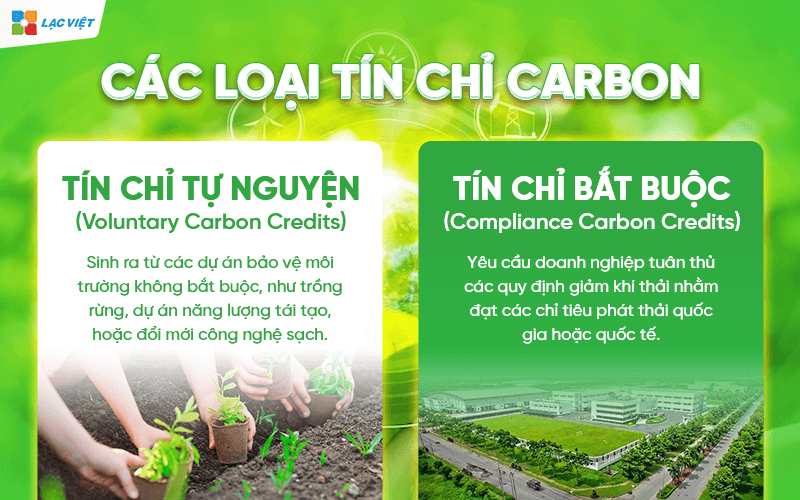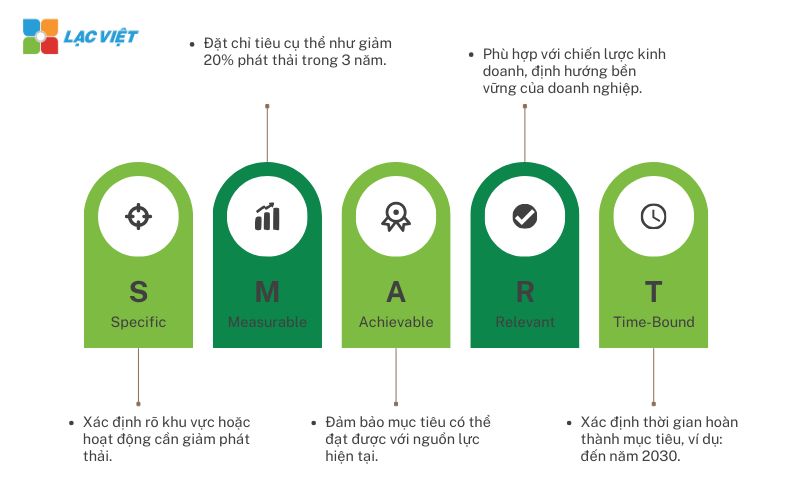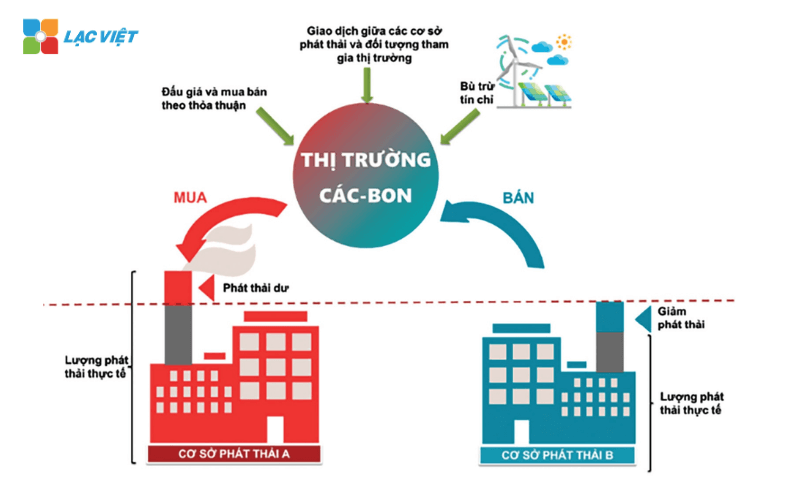In the context of climate change and demand for environmental protection is increasingly high, credits carbon has become one of the most important tools to help businesses minimize the impact on the environment.
In this article Lac Viet Computing will go deep into the concept of credit, carbon role in helping businesses transform in green business can participate in this market to achieve the sustainable development goals.
1. Credits carbon is what?
Credits carbon the unit of measure emissions of CO2 or other emissions are reduced emission or absorption through the active protection of the environment. Each certificate carbon equivalent to the reduction of 1 ton of CO2 or other greenhouse gases other. This credit was recorded as a way to help businesses deal with pressure from environmental regulations strictly.
Certificate carbon is born from projects that reduce emissions, such as project, renewable energy, reforestation, or sometimes be government issued in order to meet regulations on emission reduction.

The role of the certificate carbon in the strategic environment
- Compliance with international regulations to Help businesses comply with strict regulations on emissions reduction as in the Paris agreement on climate change.
- Market participants credits carbon: The business can sell credits in excess from the work to reduce emissions, create new source of income.
- Promote green photos: participation certificate carbon to help businesses enhance credibility and attract customers, partners have the same vision.
- System monitoring what is energy? The optimal solution to help businesses save energy
- Hydrogen what is green? New direction for the business sustainable production
- GHG Protocol what is? Implementation guide standard measurement international for business
- ISO 14064 is what? Detailed instructions building system standards credits carbon international
2. The type of signal only carbon

2.1 Credits voluntary (Voluntary Carbon Credits)
Credits voluntary was born from the project, environmental protection is not required, such as reforestation projects, renewable energy or clean tech innovation.
Type this credit in accordance with the business wishes to increase the brand value by the active involvement in environmental protection.
Credits voluntary help businesses facing international partners with photo green and sustainable commitment.
2.2 Credits required (Compliance Carbon Credits)
Credits required are managed by state agencies, or international organizations such as the European union (EU ETS) or the U.s. government.
Type this credit requires businesses to comply with regulations to reduce emissions in order to achieve the emissions targets national or international.
Credits required are usually traded in regulated markets such as the EU ETS, which allows business buying and selling the right exhaust to optimize the costs of compliance.
The participating business type of credit is usually manufacturing, energy, transportation blocks with large emissions.
Understanding the type of signal only carbon will help the business set out suitable strategies, optimize resources and increase competitive advantage in the context of green transformation.
3. Why business need to stock only carbon?
- Pressure from policy and international law
The international regulations such as System transactions emissions of the EU (EU ETS) requires businesses to cut emissions or purchase of only carbon to compensate.
In Viet Nam, the government is building policies toward emissions target of net 0 by 2050, forcing businesses to take action now.
- Economic value
Minimize costs: Businesses can save the cost of long term by investing in emission-reduction project instead of paying a fine or buy credits carbon at high prices.
Create new revenue: enterprises reduce emissions in excess can sell credits in excess on the market, generate additional revenues.
- Brand benefits
Participation in sustainability projects help businesses enhance the image in the eyes of customers, investors and partners.
Green businesses often have the ability to attract capital from investment funds, ESG (Environmental, Social, and Governance).
- Sustainability and ESG
Integrated credit only carbon on strategy ESG help business meet the expectations of the global market in terms of transparency and sustainability.
The business pioneer in emission reduction is usually achieved competitive advantage, especially when cooperation with international partners.

4. The basic steps to join a market credits carbon
Step 1: assess carbon emissions current
This is an important first step, help businesses understand the level of emissions of yourself. The evaluation process includes:
Inventory of greenhouse gas emissions (GHG Inventory): Business need statistics, all sources of emissions from production activity, operation, supply chain, operations backend. These sources are generally divided into three ranges:
- Range 1: emission sources directly from the operation of the business, such as fuel combustion in the boiler or means of transport.
- Scope 2: emission sources indirectly from energy consumption, such as electricity purchased from the national grid.
- Scope 3: All other emission source in the value chain, such as freight, handling waste or emissions from the supplier.
Use assessment tools: tools such as The GHG Protocol or ISO 14064 help businesses calculate emissions and standardized results. These tools ensure transparency, compliance with international standards.
Data analysis: Business needs sorting emission source according to level of importance, since it focuses on the source have the biggest impact to deploy the solution to reduce emissions effectively.
Step 2: Determine the goal of reducing emissions
After understanding the level of emissions, enterprises need to build the target to reduce emissions specific, clear and measurable.
Set SMART goals:
- Specific (Specific): clearly Define the area or activities to reduce emissions.
- Measurable (measurable): Set specific targets such as reducing 20% of emission in 3 years.
- Achievable (feasible): Make sure the goal can be achieved with existing resources.
- Relevant (Related): in accordance with business strategy, oriented sustainability of the business.
- Time-bound (for a limited time): determines the completion time targets, for example: to the year 2030.
Based on the business context and the law: goals need to be aligned with the legal requirements in industry and national commitments on reducing emissions as NDCs (Nationally Determined Contributions) in the Paris Agreement.
Building action plan: Businesses need to establish a detailed plan to achieve the goal, including steps taken, necessary resources, deployment time.

Step 3: market Participants credits carbon
After evaluating and determining goals, businesses can choose to market participants credits carbon in two main forms:
Voluntary market (Voluntary Market)
- In accordance with who? The business not subject to the binding legal, but want to reduce emissions, to enhance brand reputation, and attract investment.
- How to participate: Business buying credits from sustainability projects, such as renewable energy or conservation of forests. Or generate credits through projects that reduce emissions on their own.
- Advantages: Flexible, not bound legal help improve your business image.
Market required (Compliance Market)
- In accordance with who? Enterprises in heavy industry, energy, or transport must comply with regulations on emission reduction.
- How to participate: Purchase seller credits carbon on the trading floor as the EU ETS. Implementation of the project emission reductions to offset emissions exceed the permitted level.
- Advantages: Meet the legal requirements, avoid penalties and improve economic efficiency.
Expert tips
- Businesses should start from a small scale to accumulate experience before expanding the scale of market participants credits carbon.
- In cooperation with consulting organizations or international projects to ensure transparency and efficiency in the process of market participants.
- Continuously updated legal regulations and market trends in order to adjust the strategy accordingly.
5. Business can create credits carbon like?

5.1 Participate in pilot projects to reduce emissions in local time
- Planted forest and nature conservation: Vietnam has great potential for tropical forest and an area of land can recover. Businesses can join the project reforestation or conservation of existing forests to absorb CO2, creating certificates carbon.
- Investing in renewable energy: The energy project, solar, wind, or biomass not only reduce emissions but also take advantage of the preferential policies of tax-supported capital.
- Improved manufacturing process: The manufacturing enterprise can apply modern technology, optimized production chains to reduce energy consumption and greenhouse gas emissions.
5.2 connection with international organizations to develop sustainable projects
- Access to capital and technology international: Many international organizations such as The world Bank (WB), the Green Climate Fund (GCF), or the program of bilateral cooperation (such as the JCM with the Japanese) are looking for partners in Vietnam to develop emission-reduction project.
- Cooperation mechanisms in the overall credit (JCM): This is the mechanism of cooperation between Vietnam and Japan, in which the business Vietnam technical assistance and financial resources to implement projects to reduce emissions and create credit.
Credits carbon from the project in Vietnam, when certified by the international organization as the Gold Standard or Verified Carbon Standard (VCS), can trade on the international market with high value.
6. Credits carbon is certified as how?
6.1. Process certified carbon
To certificate carbon is recognized and traded on the market, projects that reduce emissions need to comply with the strict certification. Here are the main steps in the process:
Step 1: project Evaluation
- Develop project ideas: Business determine the activity has the potential to reduce greenhouse gas emissions, such as energy conversion, renewable, plantation, or improvements to the production line.
- Plan details: The project should be reported environmental assessment and the specific goal of reducing emissions, compliance with the standards of the certification organization.
- Initial approval: The certification organization will evaluate the feasibility, the potential emission reductions of the project before proceeding with the verification.
Step 2: Calculate and verify emissions reduction:
- Measurement of exhaust gas original: The project should determine the amount of CO2 emissions or greenhouse gases other before deployment.
- Calculate the amount of emission reduction: After deployment, the enterprise using the standard method to calculate the amount of greenhouse gas practice has been reduced.
- Verify by side Tuesday: The independent organization will check, verify data to ensure accuracy and transparency.
Step 3: register credits on the trading system credits:
- Register credits: After the verification of emission reduction will be converted into credits carbon and book on the system of the organization certified as Gold Standard or VCS (Verified Carbon Standard).
- Transaction credits: The credits have been registered can be sold on the market, voluntary or compulsory, depending on the type of project and goals of the business.
6.2. The certification organization popular
- Gold Standard: founded by WWF (world wide Fund for Nature), non-government organization top. Focus on projects that impact the environment, social positive, such as renewable energy, forest plantation, supply of clean water. Quality assurance certificate, which is recognized on the international market.
- Verified Carbon Standard (VCS): Is the most popular standard in the world, managed by Verra. Apply for many types of projects ranging from renewable energy, sustainable agriculture, to forest conservation. System for registration, monitoring, transparency, allowing credit widely traded in the market.
- Clean Development Mechanism (CDM): The clean development mechanism under the framework of the Kyoto protocol. Focus on projects in the developing countries, helping them to participate in carbon markets internationally.
6.3. Cost – time to certification credits carbon
Cost of certification:
- Cost of preparation of the project including planning, collecting data, preparing reports, environmental assessment. The cost of this can range from a few thousand to hundreds of thousand DOLLARS depending on the scale and type of project.
- Cost of verification: The Tuesday conduct an audit, verification of data, usually accounts for about 10-20% of the total cost.
- Free registration and maintenance: The certification organization usually charge a fee to manage, maintain, credits carbon on their system.
Certification period:
- Duration of project deployment: Depending on the scale, the project could take from 6 months to 2 years to complete phase emission reduction initially.
- Time verification and approval: this process usually takes from 3 to 6 months, including test data, field verification, the final approval.
The certification process is a complex process, but necessary to ensure the transparency and value of credit on the market. Businesses need to prepare thoroughly about resources, finance, time to implement emission-reduction project success. Cooperation with the organization certification credits will help businesses optimize benefits and enhanced credibility in the eyes of partners and investors.
7. The form of purchase and sale transactions, credit, carbon
7.1 Purchase seller credits carbon
This is the most common form in which businesses buy credits carbon from emission-reduction project, or for conservation of nature. The credits, this can be used to offset emissions due to business generated that has not be reduced immediately.
Supply credits:
- The project renewable energy: Like solar power, wind power, hydropower. These projects help reduce emissions by replacing fossil fuels.
- The project conservation and reforestation: The protection or extension of forest area helps absorb CO2 from the atmosphere, creating credits carbon.
- The initiative to reduce emissions another: such as process improvement, industrial or waste disposal clean technology.
Benefits:
- Fast: the Business can immediately offset emissions by purchasing credits.
- Flexibility: in accordance with the business hasn conditional deployment project to reduce emissions internally.
- Enhanced reputation: transparent transactions through international organizations to help improve business image.
Cost: the Price of credits carbon depends on the type of project, scope of application and the level of rarity of credits. Such credits from the project conservation of forests often have higher prices due to efficient environment long-term.

7.2 development projects to reduce emissions
Business investment into the project to reduce its emission to reduce the amount of CO2 or create credits excess carbon to the transaction.
Types of projects:
- Conversion clean energy: Installation of solar power system or wind power at the factory or office.
- Improved production line: process optimization to reduce energy consumption and emissions.
- Wm: system construction, recycling and disposal of waste, environmental friendly.
Certification process:
- Book project: Business registration project with the organization of international certification as the Gold Standard or Verified Carbon Standard (VCS).
- Monitoring and reporting: the process of project implementation should be monitored and reported periodically to ensure compliance with standards.
- Certified credit: After being proven effective, the project will be certified carbon can be used or traded.
Benefits:
- Save long-term costs: Reduce dependence on energy resources, expensive, or buy credits from outside.
- Create sources of income: Sale of credit excess in the international market.
- Contribute to sustainable development: Attached to the target ESG, enhance enterprise value in the eyes of investors.
7.3 Join the trading credits carbon international
The international exchanges provide the platform for businesses to buy or sell credits carbon with high transparency.
The exchanges downloads:
- Gold Standard: known projects with social impact and positive environment.
- Verified Carbon Standard (VCS): Focus on the big projects, have global scope.
- EU Emissions Trading System (EU ETS): the trading Floor, the world's largest, apply for business in the European union.
Transaction process:
- Account registration: Businesses need to create an account on the exchange and verification of information.
- Buy or sell credits: perform transactions through the financial instrument, similar to stock exchanges.
- Tracking and reporting: the Amount of credit transaction is updated and transparent reporting.
Benefits:
- Transparency: The transaction is tightly controlled, minimizing the risk of fraud.
- Easy access: Businesses can join from any country through the online platform.
- Strengthening international reputation: Join the trading floor big help businesses affirmed its position on the international market.
8. The real state market credits carbon in Vietnam
Vietnam is trying to build, deploy, market, credit, carbon inland to meet the goal of reducing greenhouse gas emissions and committed to reaching emissions to net 0 by 2050. Some highlights about the real state market include:
The legal framework is completed:
- Decree 06/2022/ND-CP: This is the foundation important legal help manage and control greenhouse gas emissions. This decree details the industry to inventory emissions, set quotas, transaction certificate.
- Program action country: The government has approved plans to build trading systems, carbon expected pilot from the year 2025 and deploy comprehensive from the year 2028.
The key fields:
- Heavy industries, such as cement, steel, chemicals are identified as main subjects in the pilot phase.
- Projects on renewable energy, waste management, forest conservation, are to be preferred developer to create credit only high-quality carbon.
Vietnam is cooperating with international organizations to build systems project registration and certification. This ensures credit local meet international standards, help to increase transparency and value in the international market.
The big business in Vietnam, especially in the field of manufacturing and energy, attention has begun to invest in emission-reduction project. This is a positive signal for the development of the market of credit, carbon interior.
9. The industry in accordance with market credits carbon
The sector of renewable energy, industrial production, agriculture, forestry has great potential to market participants credits carbon. By implementing projects to reduce emissions accordingly, this industry does not only contribute to the goal of reducing greenhouse gas but also bring economic benefits and sustainable. Business in these areas need to quickly seize the opportunity to just meet the legal requirements just create competitive advantages on the international market.

9.1. Renewable energy
The renewable energy sector plays an important role in reducing CO2 emissions by substituting fossil energy sources such as coal, oil, gas. The project development of clean energy such as solar power, wind power, biomass energy not only reduce emissions but also create energy credits, carbon has high value.
The form of project match:
- Project solar power and wind power: installing the system battery solar or wind turbine to help reduce dependence on fossil energy, at the same time attractive thanks to the investment cost is increasingly reduced.
- Project biomass energy: Using agricultural products or organic waste to produce energy, reducing emissions from waste and create sustainable energy sources.
Benefits:
- Save energy costs long-term.
- Create credits carbon can be traded on the international market.
- Get the preferential tax policy and capital from the state.
9.2. Industrial production
The manufacturing industry accounts for a large proportion of the total emissions greenhouse, in particular in areas such as steel, cement, chemicals, food processing. The application of the solution energy saving and green technology helps reduce emissions significantly and generates credits carbon.
The form of project match:
- Improvement of production lines: Replace or upgrade machinery current technology, energy efficiency than, for example, furnaces, energy-saving or air compressor improvements.
- Use of renewable energy in the production of: Installation of solar power system on the roof of the workshop or the use of biomass energy for the production process.
- Management of industrial waste: process optimization, waste reducing methane emissions from landfills or from waste water.
Benefits:
- Reduce operating costs through energy savings.
- Increased competitiveness thanks to meet the standards of ESG.
- Create opportunities to sell credits carbon excess for other businesses.
9.3. Agriculture and forestry
Agriculture and forestry are the areas just emissions just absorb greenhouse gases. The project, reforestation, forest conservation, improved farming methods not only reduce the amount of CO2 in the atmosphere, but also create credit sustainable.
The form of project match:
- Afforestation and reforestation: planting projects new forest or forest restoration degraded helps to absorb CO2 naturally and create certificates carbon has high value.
- Improved methods of cultivation: Apply the method of sustainable farming as using organic fertilizer, reducing the amount of nitrogen fertilizer, chemical, farming without tilling to reduce emissions from land.
- Management of livestock waste: construction, handling systems, livestock waste, such as biogas systems, helping to reduce emissions of methane from livestock.
Benefits:
- Create economic value from credits through conservation projects and reforestation.
- Raise incomes for farmers, the local community, from participating in the project to reduce emissions.
- Contribute to the objective of sustainable development of the country.
Certificate carbon is not just a tool to help businesses meet the legal requirements and international on reducing greenhouse gas emissions, but also opens many opportunities for sustainable development, enhance brand value. In the context of the world increasingly attach importance to the green transformation, market participation credits carbon is step strategy to help businesses improve competitiveness, optimize costs and contribute to the objective of sustainable development globally.
However, to succeed, businesses need to understand the certification process, choosing the form of appropriate transaction, investment in the project has long term potential. The cooperation with prestigious organizations and leverage the support policy will also help businesses optimize the benefits from credit carbon.













